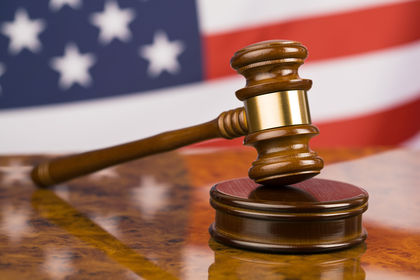United States - Judicial system

The Supreme Court, established by the US Constitution, is the nation's highest judicial body, consisting of the chief justice of the United States and eight associate justices. All justices are appointed by the president with the advice and consent of the Senate. Appointments are for life "during good behavior," otherwise terminating only by resignation or impeachment and conviction.
The original jurisdiction of the Supreme Court is relatively narrow; as an appellate court, it is open to appeal from decisions of federal district courts, circuit courts of appeals, and the highest courts in the states, although it may dismiss an appeal if it sees fit to do so. The Supreme Court, by means of a writ of certiorari, may call up a case from a district court for review. Regardless of how cases reach it, the Court enforces a kind of unity on the decisions of the lower courts. It also exercises the power of judicial review, determining the constitutionality of state laws, state constitutions, congressional statutes, and federal regulations, but only when these are specifically challenged.
The Constitution empowers Congress to establish all federal courts inferior to the Supreme Court. On the lowest level and handling the greatest proportion of federal cases are the district courts—including one each in Puerto Rico, Guam, the Virgin Islands, the Northern Mariana Islands, and the District of Columbia—where all offenses against the laws of the United States are tried. Civil actions that involve cases arising under treaties and laws of the United States and under the Constitution, where the amount in dispute is greater than $5,000, also fall within the jurisdiction of the district courts. District courts have no appellate jurisdiction; their decisions may be carried to the courts of appeals, organized into 13 circuits. These courts also hear appeals from decisions made by administrative commissions. For most cases, this is usually the last stage of appeal, except where the court rules that a statute of a state conflicts with the Constitution of the United States, with federal law, or with a treaty. Special federal courts include the Court of Claims, Court of Customs and Patent Appeals, and Tax Court.
State courts operate independently of the federal judiciary. Most states adhere to a court system that begins on the lowest level with a justice of the peace and includes courts of general trial jurisdiction, appellate courts, and, at the apex of the system, a state supreme court. The court of trial jurisdiction, sometimes called the county or superior court, has both original and appellate jurisdiction; all criminal cases (except those of a petty kind) and some civil cases are tried in this court. The state's highest court, like the Supreme Court of the United States, interprets the constitution and the laws of the state.
The grand jury is a body of from 13 to 24 persons that brings indictments against individuals suspected of having violated the law. Initially, evidence is presented to it by either a justice of the peace or a prosecuting county or district attorney. The trial or petit jury of 12 persons is used in trials of common law, both criminal and civil, except where the right to a jury trial is waived by consent of all parties at law. It judges the facts of the case, while the court is concerned exclusively with questions of law. The US accepts the compulsory jurisdiction of the International Court of Justice with reservations.
Thank you,
joehakun@verizon.net
Again, I thank you,
Janice Cooperman